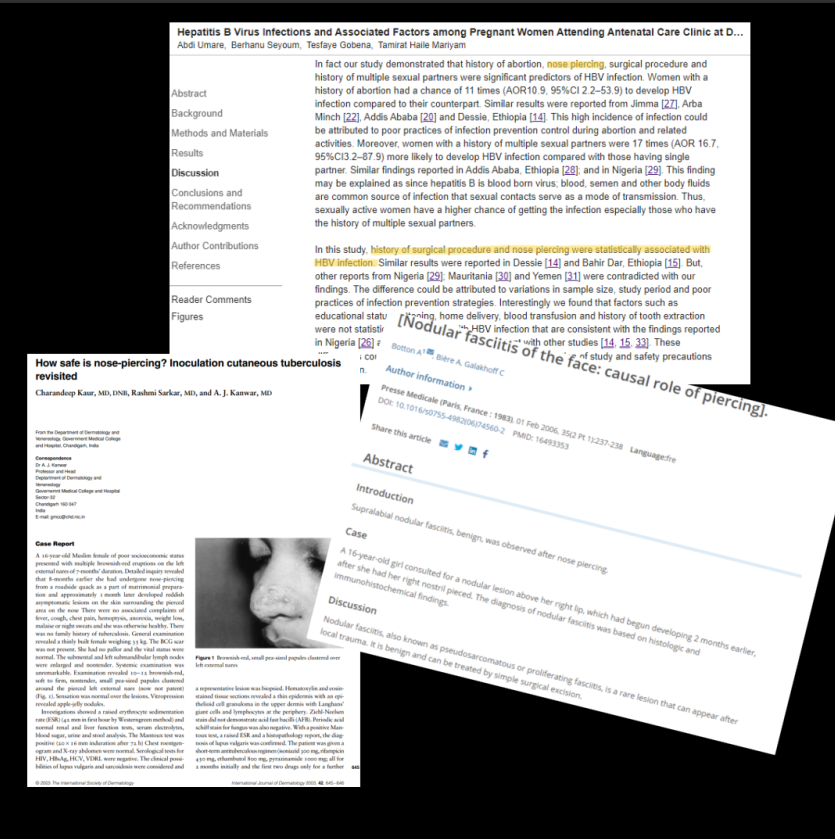
Once more I come as a fellow sister in Christ in love and gentle guidance with a study I’ve been working on. This is not an exhaustive study, but a brief overview for consideration as you delve into your own studies of Scripture and how it applies to this topic using proper interpretation.
After seeing so many young men and women jumping on board with putting a ring through their nose, I wanted to “dig” a little deeper and get to the “root” of this practice.
I first looked at why rings are pierced into the snouts of animals, namely pigs and bulls.
“Nose rings are put on pigs to control a behavior called ‘rooting.’ That is when a pig uses its strong snout to dig around in the dirt as he looks for food or other underground substances that interest him. Pigs root quickly and can destroy large areas of land in no time. They can also end up removing protective barriers by rooting near the edges of their enclosures and uprooting fence posts” (Enright).
“Bulls are heavy and unpredictable animals, and their noses are one of their most sensitive parts of the body. For that reason, farmers, or veterinarians, put a steel ring through their noses, so they are more easily managed… so they can be controlled” (UntamedAnimals.com).
Every instance these are used seem to align with control. The control of an unruly animal by its owner. Keep this in mind, we will revisit this in a bit ![]() .
.
Why and how did that get transferred to humans?
First, I turned to the Genesis 24 account of Rebekah having a “nose” ring (because many people point this out in defense of the practice). I wanted to understand this a little better. Multiple translations of the Scriptures, even including Hebrew texts of the Torah-Pentateuch, offered conflicting interpretation of verse 22 & 30. This original term נֶזֶם nezem means ring, including ring, nose ring, and earring. The term’s etymology is “from an unused root of uncertain meaning” (Blue Letter Bible). It is simply a gold ornament for adorning. This interpretation varies as seen in multiple translations—some refer to it as a nose ring, some to a ring, and some to an earring. However, moving to verse 47, which states, “So I put the ring on her nose and the bracelets on her wrists,” the action of putting the ring on her nose comes up. The original Hebrew used here is עַל ʻal for “on,” meaning “In connection with verbs of motion (actual or figurative) … to put upon” (Blue Letter Bible). This word is also used in the same context in Genesis 22:6 “And Abraham took the wood of the burnt offering, and laid it upon Isaac his son,” and Genesis 21:14 “So Abraham rose early in the morning and took bread and a skin of water and gave it to Hagar, putting it on her shoulder.” The original Hebrew word for nose here is אַף ʼaph or ‘ap̄ , meaning “nose, nostril, face” (Blue Letter Bible).
Now, it’s interesting to me that the word chosen for the action is “on.” Not “in” or “through.” Genesis 35: 4 says, “So they gave to Jacob all the foreign gods that they had, and the rings that were in their ears.” Here, the term “in” is used. Also, according to TNIV Study Bible’s footnotes in reference to Ezekiel 16:12 (“And I put a ring on your nose and earrings in your ears and a beautiful crown on your head.”), this is “Not piercing the nose but worn on the outside part of the nose.” Notice again the use of “on” and “in”— “on” your nose, but “in” your ears (“in” is אֹזֶן ʼôzen, a different word altogether).
Speaking of Ezekiel, this is a prophetic message concerning judgment on Jerusalem and Judah—namely Jerusalem, the foundling bride in this passage. It is a metaphorical descriptive text which includes an “abandoned girl (v.6) who becomes a queen (v. 13) … the sexual promiscuity of the ‘queen,’…[and] the impending judgment on the faithless bride” (ESV Study Notes). The metaphorical description of being adorned with ornaments was to demonstrate gifts given, concluding in status of royalty.
Ornamental adornment was, and still is today, a signifier of status.
There’s much debate around piercing’s paganistic traditions as well. A secular description written by John A. Rush states, “Tattooing, scarification, implants, and piercing might be seen…as a glorification of the human body with an enjoyment of fleshiness and sensuality, symbols to be seen and appreciated” (19).
Most people would agree with Rush that one uses adornment today to seek attention, to indulge in the flesh and the sensual, to gain attention.
But as Christians, doesn’t this raise a red flag?
It certainly does for me.
Going back to those pigs and bulls which are controlled by such an act, such an item, when we who have submitted to Christ receive the Holy Spirit, we have self-control. The Holy Spirit is self-control (Galatians 5: 23). We are instructed to walk by the Spirit, not gratifying the desires of the flesh (Galatians 5). And when we look at prescriptive Scripture such as 1 Peter 3:3-4 and 1 Timothy 2:9, and we know we are set apart from the world, holy and sanctified, we see we shouldn’t be quick to adopt practices the world is accustomed to displaying. I’ve written about this in entries such as MODEST, EKKLESIA, and COMMON STRUGGLES.
I thought it was interesting to include the fact that piercing isn’t just a spiritual matter, but it causes physical hardship as well. Piercing and other bodily alterations cause physical deformities, infections, and other bodily harm.
Here are some studies of which to take note:


All in all, as I have typically said before, when in doubt…better safe than sorry. I cannot see where this paganistic practice can be justified or is in any way beneficial, but -in fact- is often detrimental both spiritually and physically. Therefore, being holy and set apart, I cannot support such a practice. I implore you to continue your own studies with proper exegesis and hermeneutics, not only in this area, but every area of your walk, as we should.
Love, peace, and grace ![]()
References
Enright, June. September 26, 2017. FACTS OF NOSE RINGS IN PIGS. Retrieved August 25, 2022, from https://animals.mom.com/difference-between-pig-peccary-5943.html
UntamedAnimals.com. 2022. Why do Bulls and Cows Have a Nose Ring? Retrieved August 25, 2022, from https://untamedanimals.com/why-do-bulls-and-cows-have-a-nose-ring/
Collage 1:
Hepatitis B Virus Infections and Associated Factors among Pregnant Women Attending Antenatal Care Clinic at Deder Hospital, Eastern Ethiopia Abdi Umare ,Berhanu Seyoum,Tesfaye Gobena,Tamirat Haile Mariyam. Published: November 29, 2016. https://doi.org/10.1371/journal.pone.0166936
Botton A, Bière A, Galakhoff C. [Nodular fasciitis of the face: causal role of piercing]. Presse Medicale (Paris, France: 1983). 2006 Feb;35(2 Pt 1):237-238. DOI: 10.1016/s0755-4982(06)74560-2. PMID: 16493353.
How safe is nose-piercing? Inoculation cutaneous tuberculosis revisited Charandeep Kaur, MD, DNB, Rashmi Sarkar, MD, and A. J. Kanwar, MD j.1365-4362.2003.01947.x20161006-16011-5omuv1-with-cover-page-v2.pdf (d1wqtxts1xzle7.cloudfront.net)
Collage 2:
Beers, Melody S. MSN, ARNP, BC; Meires, Jan EdD, ARNP, BC; Loriz, Li PhD, ARNP, BC. Body Piercing: Coming to a Patient Near You. The Nurse Practitioner: February 2007 – Volume 32 – Issue 2 – p 55-60
Andrew D.H. Wilson, Howard Rigby, Antonio Orlando, Atypical cellular neurothekeoma – a diagnosis to be aware of, Journal of Plastic, Reconstructive & Aesthetic Surgery, Volume 61, Issue 2, 2008, Pages 186-188, ISSN 1748-6815, https://doi.org/10.1016/j.bjps.2007.01.078 (https://www.sciencedirect.com/science/article/pii/S174868150700335X)
